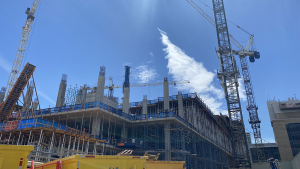VICTORIA – The British Columbia Construction Association (BCCA) says its fall statistics package reflects a “challenging state” for the provincial construction industry.
BCCA and Sage Policy Group’s October 2023 statistical report said investment in buildings in B.C. remains subdued and that a 10 per cent post-pandemic rebound during the first nine months of 2022 has now dissipated.
“Construction has never been busier, yet the pressures to meet this demand are equally high. Interest rates, rising wages and the high cost of materials all factor into the equation. It is clear that these pressures are causing layoffs. We’ve seen indications that construction workers, both skilled and unskilled, are moving out of the province as a direct result of B.C.’s high cost of living, housing shortage, and the perception of better opportunities elsewhere,” said BCCA president Chris Atchison in a statement.
“Our workforce is invaluable, and we cannot afford to lose a single tradesperson or journeyperson. B.C. needs an effective affordable multi-unit housing strategy aimed at keeping workers like those in the construction sector within the province,”
The report said “a combination of high interest rates and the corrosive impacts of excess inflation have conspired to reignite the slump. Through the first half of 2023, real investment in ICI construction has been essentially flat (-1.6 per cent) and remains nearly 14 per cent below its 2019 peak.”
In nominal terms, spending on building construction exceeds pre-pandemic levels and is up 10 per cent since February 2020 but the report cautioned this is because the cost of delivering construction services has gone up due to worker shortages, long lead times for equipment and other construction inputs along with difficulty obtaining timely payment from purchasers of construction services.
It added institutional and government construction have been the only segments to show growth since the start of the pandemic, which served to obscure a lack of momentum in other categories.
Investment in government and ICI construction has expanded 45 per cent since February 2020 while industrial construction in B.C. stagnated, down 12 per cent in real terms, four per cent in nominal terms over the past year and nine per cent since the start of the pandemic.
“The lack of industrial construction in British Columbia is likely attributable to many factors, but one of them is America’s industrial policymaking, which through federal tax credits is inducing large manufacturers to shift supply chain capacity to the U.S. despite the strength of the U.S. dollar (which frustrates export growth) and the relative weakness of the Canadian dollar,” the report stated.
A decline in construction employment was also cited as a problem, with B.C.’s construction employment base shrinking by 14,500 workers, a six per cent drop, which the report called “easily the worst performance of any Canadian province in both absolute and percentage terms.”
Many of those job losses were in the Lower Mainland in the territory covered by the Vancouver Regional Construction Association which is also the largest employment base of the province’s four construction association regions with nearly 60 per cent of B.C. construction jobs.
The report cited remote work and households moving to cheaper regions during the pandemic as reasons for the shift, but also pointed out only the Northern Regional Construction Association (NRCA), which covers northern B.C., reported more construction than pre-pandemic, with their employment base at 4.4 per cent since February 2020.
“However, the NCRA is the BCCA’s region with the fewest construction employees and its growth amounts to just 700 net new jobs,” the report said.
The report also said construction remains the top rank as an employer in B.C.’s goods sector with $174 billion in value of proposed construction projects, $157 billion in current construction and the industry contributing 10.3 per cent to the province’s GDP.
The report concluded by stating movement is needed on prompt payment and other issues if B.C.’s construction industry is to continue to grow.
“Pressures applied by higher wages and still-elevated materials prices are severely exacerbated by the province’s lack of a prompt payment policy. Until British Columbia catches up legislatively with the balance of Canada regarding such policy-making, provincial contractors will continue to struggle with outsized financial risks and be more likely to falter,” the report stated.
“Government seems to be under the illusion that contractors all have the deep pockets needed to essentially fund large-scale projects. Not so. About 90 per cent of B.C. contractors are small companies, and they are often paid three or six months after the last nail has been pounded, or the last coat of paint has dried. No other industry has to endure that,” Atchison said.
“Last spring, we were encouraged to hear that the attorney general would be convening a large table working group on this issue. We’re still waiting. The time to talk has passed. The time to act is now. The situation is dire. Unlocking cash flow is an economic necessity and in the best interests of every community in British Columbia.”











Recent Comments
comments for this post are closed